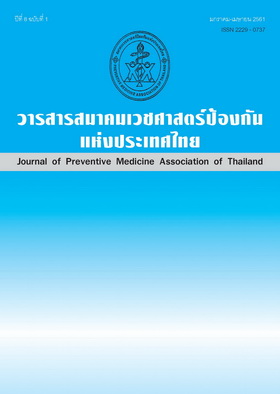Groups of the High-burden Occupational Disease
Abstract
The objective of this study was to explore characteristics of groups of the high-burden occupational disease and its disease proportion priority and then use that information for decision making on resource allocation in occupational medicine practices. The method comprised of defining needed information of the studied population, developing a studied tool, analyzing data of 298 patients from the diagnosed reports 2017 under the responsibility of Thailand workmen’s compensation fund for grouping patients according to their common characters, assessing and concluding a result. In a Thai context, high-burden occupational diseases distributed in the four disease groups: Group 1 the injury, Group 2 the illnesses, Group 3 the biomechanical injuries and chronic cumulative injuries/illnesses, and Group 4 the psychosocial health problems. The highest disease incidence was from the Group 1. The number-one high-burden occupational disease of this studied population was the injury and illness of the musculoskeletal system utilizing 77.4% of total high-cost medical treatment expense. The researcher proposes that there should have a project, to define a standard definition of the occupational hazards those cause the big Four Disease Groups, and to support the disease incidence information collection according to those established groups. Then, the responsible organizations could have
had that crucial information for the allocation of physicians and resources and to support the development of knowledge packages for individuals accordingly. All these aims at an effective reducing the incidence of disease.
References
2. กองสุขศึกษา กรมสนับสนุนบริการสุขภาพ กระทรวงสาธารณสุข. รายงานผลการประเมินความรอบรู้ด้านสุขภาพและพฤติกรรมสุขภาพประชาชนวัยทำงาน (อายุ 15-59 ปี) ปีงบประมาณ 2559 [อินเทอร์เน็ต]. 2560 [เข้าถึงเมื่อ 18 ส.ค. 2560]. เข้าถึงได้จาก: https://www.hed.go.th/linkHed/index/2
3. ประกาศกระทรวงแรงงานเรื่องกำหนดชนิดของโรคซึ่งเกิดขึ้นตามลักษณะหรือสภาพของงานหรือเนื่องจากการทำงาน. (2550, 15 สิงหาคม). ราชกิจจานุเบกษา. เล่ม 124 ตอนพิเศษ 97 ง. หน้า 9-12.
4. คณะอนุกรรมการการแพทย์หน่วยที่ 3 ที่มี รศ. นพ.ศุภชัย รัตนมณีฉัตร เป็นประธาน ตามคำสั่งกองทุนเงินทดแทนที่ 16/2559 ลงวันที่ 14 ธันวาคม พ.ศ. 2559. รายงานการประชุมคณะอนุกรรมการการแพทย์ (ครั้งที่ 1/2560 ถึง 19/2560) ที่เป็นผลจากลูกจ้าง 298 คน เป็นผู้ยื่นเรื่องเพื่อรับการวินิจฉัยประเด็นโรคที่เกิดขึ้นเนื่องจากการทำงาน ในรอบ 1 ปี พ.ศ. 2560; 31 มกราคม, 7 และ 28 กุมภาพันธ์, 7 และ 21 มีนาคม, 4 และ 18 เมษายน, 2 และ 16 พฤษภาคม, 6 และ 20 มิถุนายน, 4 และ 18 กรกฎาคม, 1 และ 15 สิงหาคม, 12 และ 19 กันยายน, และ 3 และ 17 ตุลาคม ห้องประชุมสำนักงานประกันสังคม จังหวัดปทุมธานี. นนทบุรี: กองทุนเงินทดแทน คณะกรรมการการแพทย์; 2560.
5. ประกาศกระทรวงแรงงานและสวัสดิการสังคม เรื่องหลักเกณฑ์การวินิจฉัยและการประเมินการสูญเสียสมรรถภาพของผู้ป่วยหรือบาดเจ็บด้วยโรคจากการทำงาน. (2540, 30 พฤษภาคม). ราชกิจจานุเบกษา ฉบับประกาศทั่วไป. เล่ม 114 ตอนพิเศษ 39 ง. หน้า 7-8.
6. ประกาศกระทรวงแรงงานและสวัสดิการสังคม เรื่องหลักเกณฑ์การวินิจฉัยและการประเมินการสูญเสียสมรรถภาพของผู้ป่วยหรือบาดเจ็บด้วยโรคจากการทำงาน (ฉบับที่ 2). (2541, 24 เมษายน). ราชกิจจานุเบกษา ฉบับประกาศทั่วไป. เล่ม 115 ตอนพิเศษ 31 ง. หน้า 8-9.
7. โยธิน เบญจวัง, วิลาวัณย์ จึงประเสริฐ, บรรณาธิการ. มาตรฐานการวินิจฉัยโรคจากการทำงาน ฉบับเฉลิมพระเกียรติเนื่องในโอกาสมหามงคลเฉลิมพระชนมพรรษา 80 พรรษา 5 ธันวาคม 2550. นนทบุรี: สำนักงานกองทุนเงินทดแทน สำนักงานประกันสังคม กระทรวงแรงงาน; 2550.
8. อดุลย์ บัณฑุกุล. การวินิจฉัยโรคจากการทำงานโดยใช้ Nine steps in occupational disease diagnosis. วารสารกรมการแพทย์ 2559;41(2):5-12.
9. สำนักโรคจากการประกอบอาชีพและสิ่งแวดล้อม กรมควบคุมโรค. แนวทางการวินิจฉัยโรคและภัยจากการประกอบอาชีพเบื้องต้นสำหรับหน่วยบริการสาธารณสุข. พิมพ์ครั้งที่ 2. กรุงเทพฯ: ชุมนุมสหกรณ์การเกษตรแห่งประเทศไทย; 2555.
10. International Labor Organization. Recording and notification of occupational accidents and diseases. Geneva: ILO; 1996.
11. Levy BS, Webman DH, Baron SL, Sokas RK, editors. Occupational and environmental health: recognizing and preventing disease and injury. 5th ed. Philadelphia: Lippincott Williams & Wilkins; 2006.
12. Kang S-K, Kim EA. Occupational diseases in Korea. J Korean Med Sci 2010;25(Suppl): S4-12.
13. International Labor Organization. List of occupational diseases (revised 2010). Identification and recognition of occupational diseases: Criteria for incorporating diseases in the ILO list of occupational diseases. Geneva: International Labor Office; 2010 (occupational safety and health series, no. 74).
14. Institute for health metrics and evaluation. Global burden of disease (GBD) and of Thailand. [Internet]. 2016 [cited 2018 January 26]. Available from: https://www.healthdata.org/thailand
15. สำนักงานพัฒนานโยบายสุขภาพระหว่างประเทศ. การประเมินและเปรียบเทียบภาระโรคและปัจจัยเสี่ยง (Comparative risk assessment: CRA) รายงานภาระโรคจากปัจจัยเสี่ยงของประชากรไทย พ.ศ. 2552. นนทบุรี: ครีเอทีฟกูรู; 2556 [เข้าถึงเมื่อ 30 มี.ค. 2561]. เข้าถึงได้จาก: https://bodthai.net
16. ชุษณะ มกระสาร, บรรณาธิการ. Thailand medical services profile 2011-2014 (การแพทย์ไทย 2554-2557). กรุงเทพฯ: กรมการแพทย์ กระทรวงสาธารณสุข; 2557.
17. มูลนิธิเพื่อการพัฒนานโยบายสุขภาพระหว่างประเทศ, สำนักงานพัฒนานโยบายสุขภาพระหว่างประเทศ. รายงานภาระโรคและการบาดเจ็บของประชากรไทย พ.ศ. 2557. นนทบุรี: เดอะกราฟิโก้ซิสเต็มส์; 2560.
18. Chaffin DB, Andersson G.BJ, Martin BJ. Occupational biomechanics. 4th ed. New Jersey: John Wiley & Sons; 2006.
19. Loeppke R, Heron R, Bazas T, Beaumont D, Spanjaard H, Konicki DL, et al. Global trends in occupational medicine: results of the international occupational medicine society collaborative survey. JOEM 2017;59:e13-16.
20. Pruss-Ustun A, Corvalan C. Preventing disease through healthy environments. Towards an estimate of the environmental burden of disease. France: World Health Organization; 2006.
21. Nelson DI, Concha-Barrientos M, Driscoll T, Steenland K, Fingerhut M, Punnett L, et al. The global burden of selected occupational diseases and injury risks: Methodology and summary. Am J Ind Med 2005;48:400-18.
Downloads
Published
How to Cite
Issue
Section
License
บทความที่ลงพิมพ์ในวารสารเวชศาสตร์ป้องกันแห่งประเทศไทย ถือเป็นผลงานวิชาการ งานวิจัย วิเคราะห์ วิจารณ์ ตลอดจนเป็นความเห็นส่วนตัวของผู้นิพนธ์ กองบรรณาธิการไม่จำเป็นต้องเห็นด้วยเสมอไปและผู้นิพนธ์จะต้องรับผิดชอบต่อบทความของตนเอง






